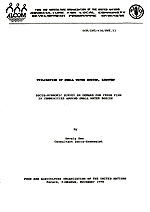
GCP/INT/436/SWE.11
 | UTILIZATION OF SMALL WATER BODIES, LESOTHO |
SOCIO-ECONOMIC SURVEY ON DEMAND FOR FRESH FISH
IN COMMUNITIES AROUND SMALL WATER BODIES
by
Sevaly Sen
Consultant Socio-Economist
This report was prepared during the course of the project identified on the title page. The conclusions and recommendations given in the report are those considered appropriate at the time of its preparation. They may be modified in the light of further knowledge gained at subsequent stages of the project.
The designations employed and the presentation of the material in this document do not imply the expression of any opinion whatsoever on the part of the United Nations or the Food and Agriculture Organization of the United Nations concerning the legal or constitutional status of any country, territory or sea area, or concerning the delimination of frontiers.
The socio-economic survey on demand for fresh fish in communities around small water bodies in Lesotho, reported in this document, was undertaken by ALCOM in collaboration with the Fisheries Section, Ministry of Agriculture, and with assistance from the Bureau of Youth and Women's Affairs. The survey was part of the preparatory phase of a pilot project on improved management of and production from small water bodies.
ALCOM, (Aquaculture for Local Community Development Programme) is executed by FAO and funded by Sweden (SIDA). It is an inter-regional programme, although focusing its activities to the SADCC countries of Southern Africa.
The objective is to develop, test, and demonstrate methods and techniques by which rural people can improve their standard of living through aquaculture and to assist participating countries in generating larger scale development projects applying the results from the methodology development.
Addresses :
| Harare | Mail : | P O Box 3730, Harare, Zimbabwe |
| Telex : | 26040 FAO ZW | |
| Fax : | 263-4-729563 | |
| Lusaka | Central Fisheries Research Institute, Chilanga | |
| Mail : | P O Box 30563, Lusaka, Zambia | |
| Telex : | 44510 FAO ZM ZA | |
| Fax : | 260-1-221927 | |
FOOD AND AGRICULTURE ORGANIZATION OF THE UNITED NATIONS
Harare, Zimbabwe, November 1990
Hyperlinks to non-FAO Internet sites do not imply any official endorsement of or responsibility for the opinions, ideas, data or products presented at these locations, or guarantee the validity of the information provided. The sole purpose of links to non-FAO sites is to indicate further information available on related topics.
This electronic document has been scanned using optical character recognition (OCR) software. FAO declines all responsibility for any discrepancies that may exist between the present document and its original printed version.
3.4 Introduction of the survey team to villages
3.5 Brief description of the areas selected
3.5.1 Area 1: Ha Ramapepe and Thaba Patsoa, Leribe District
3.5.2 Area 2: Ha Mafefooane, Tleutle Ha Mpiti, Ha Shale and Pae-Lea-Ithatsoa, Maseru District
4.1 Summary of Results from Conducted Interviews
4.1.1 Household size and composition
4.1.2 Household composition by household head
4.1.6 Consumption of fresh fish
4.1.7 Seasonal availability and source of fresh fish
4.1.8 Preparation of fresh fish
4.1.9 Reasons why households do not eat fresh fish more often
4.1.10 Consumption of other types of fish
4.1.13 Preferences for fish and ducks compared to chicken
4.1.14 Taboos concerning the consumption of fish and ducks
4.2 Results of the Sesotho Questionnaire
5. Existing Information on Fish Consumption
5.2 The household budget survey 1986/87
5.3 The World Food Programme (WFP)
5.4 Other Sources of Information
Appendix 2 Sample selection for interviews
Appendix 3 Private consumption according to household budget survey
Appendix 4 Results of the socio-economic survey undertaken by the Lesotho Highlands Development Authority